The decision to travel to Montreal was clear: Yoshito Ohno would perform at L’Agora de la Danse and I wanted to see him on stage; as I knew Jocelyne Montpetit lived there, I hoped that she could give one of her workshops during the period that master Ohno would be performing. And so it was, as part of a 4 weekend workshop, I took 4 very productive sessions (two weekends).
It is known that if one does not work with a teacher (whether it be Jocelyne Montpetit or Yoshito Ohno) a longer time, like at his/her studio every day, for example, there is a danger that each of those "short" workshops that one is taking in this or that place could be the same as others you have already taken before. I did not consider it such a big problem in my case. I'm still in the very base of the pedagogical work of Butoh and a renewal of what I had taken with Montpetit would be a reinforcement, or at least one good review.
I'll do a simple (but not hollow) description of the 4 sessions, because I wanted to include them all in this post:
The sessions were conducted in an imposing building, the old library of Montreal city, today the offices of the National Arts Council, in one of several studios or rehearsal rooms that are very well adapted for performing arts works.
Jocelyne Montpetit was usually there before our sessions, rehearsing or working with others students. Close before 3 pm she would come to greet us and invite us to enter to the classroom.
Each session lasted 2 hours, from 3PM to 5 PM and there was always music to work. Jocelyne usually gave an indication with a very small theoretical framework or story according to the objective of the exercise to come. Her comments after each exercise were always general (perhaps another story concerning the purpose of the exercise), and only in very special cases were there comments directed at a specific person.
Session 1: Golden threads, wind blows and eyes on the forearms.
- Walking with the image of golden threads which pull from the center of the body and arms (a thread in each finger) to the sky and, once we are at the highest point, on the verge of crashing down, the same golden threads pull us down, taking all our body (and fingers) to the ground.
- Walking while the wind hits parts of our body. We would have to open the body itself to the wind, as if there was a hole in our torso where the wind could pass. This was an idea of Kazuo Ohno: "open the body."
- Walking as if blind: our eyes in the head do not work anymore, our eyes are now in the forearms, and they lead our walking. We move towards where our eyes in the forearms look. Jocelyne asks us to walk in different levels, to the sky and to the ground. Our movement is slow, careful, gentle. For the first time I have a much more sensitive perspective of Maeterlinck's play "Les aveugles".
The exercises are long, a long time is dedicated to each one of them. Jocelyne, during the exercise, approaches and sometimes gives directions, sometimes touching parts of our body and provoking a different movement, more directed at what she believes is the purpose of the exercise. Sometimes, very rarely, someone in the group speaks or even complains about an indication, but that is exceptional, generally all our work is silent.
The music is varied and uniquely beautiful, profound and inspiring: Arvo Pärt, Maria Callas, Jessy Norman, some pieces of Latin Blues, Fado, and so on.
Jocelyne likes to work in groups. The same exercise is repeated in small groups, dividing the whole group in two, or all together with a final indication of movement, as if she were directing a choreography.
Session 2: A sheet of silk in the hands, a soap bubble that should not be broken, the blind and the wind blows again.
- Moving with a sheet of silk in our hands, an imaginary sheet of silk with a small bubble in the middle. Our feet are as soft as the silk in our hands. Jocelyne talks about Noh theater and tells us about that child that had to learn to walk smoothly for years to make his debut, coming and going unnoticed for an entire 5-hour performance.
- Walking with a large soap bubble in the hands, a continuous movement with that bubble in different levels of high. Attention to the other soap bubbles, some are already on the ground and we should avoid breaking them. There should be an exaggerated attention to the whole space, the space itself is a soap bubble, we must avoid breaking the space.
Jocelyne recalls how in Japan, waiting for an appointment with an blind acupuncturist, there was a child playing quietly in the middle of the waiting room; when the blind acupuncturist opened the door and came forward, he gently stopped when he felt the child playing on the floor, then continued walking around the boy... With that attention we should move throughout the space.
- Walking as if blind with our eyes on the forearms again: we did it alone, in small groups, with the entire group split in two.
- Walking with the wind hitting us. Again we work in small groups, different levels of wind force hitting us; at times the wind pushes a particular part (the shoulder, for example), then the whole torso, sometimes we fall to the ground because of the power of the wind blowing; when we come back to walk, we do it facing it, its force against us.
Session 3: Bones movement, a carp moving inside our body, a million small flowers on the ground, and Ophelia with long hair, moved by the river flow.
- All movement start where our joints begin. Hijikata called it "movement of the bones". One special way to move, a way of being fully present during the movement. The idea of moving from the joints is not a technical idea, it is not a doll or robot that moves, we would have to find the soul of the movement of the bones.
As to being present while moving, Jocelyne recalls that Kazuo repeated the same question to his students during the improvisations: "Where are you? Where are you?”.
- Being moved by a carp swimming in our body. This is another story of Kazuo’s: when Kazuo’s mother was dying, she told him she felt something like a carp moving inside throughout her body; without thinking about it, she had taught Kazuo a new way of moving on stage. A carp should lead our movement.
- As we move we have to avoid crushing a million tiny flowers in the ground, we should be delicate and light. It is an image by Hijikata, to silence the movement of the body.
- Walking mixing the inner movement of the carp, and avoiding crashing that million tiny flowers.
The music, as usual, is deep, sensitive, charming. The energy is perceived in all of us; my walking is very delicate and sensitive, emotions run freely.
The difficulty of working with these two images is part of the challenge of the Butoh conceived by Hijikata: Multiple images provoking different movements simultaneously. Jocelyne remembers that one of Hijikata’s collaborators was able to manage up to 60 images in one sequence.
Jocelyne speaks about images and mixes that word with "visions"; sometimes images are visions, sometimes visions are images.
- We are Ophelia, Shakespeare’s Ophelia (even though our images inevitably are mixed with those by the painters who have also recreated the character). In the river, inside the water our immensely long hair is pulled by the river flow. There is no acting, but living the image. The music by Arvo Pärt, so beautiful, creates a blast of emotion, mixed with the strength of Shakespeare’s scene.
Jocelyne splits the group in two, women and men; one group watches the other. She loves how our movements look.
Session 4: A "Dandelion", moving bones, the carp, a million flowers, and Ophelia who dies again.
- We have to become a dandelion and use the onomatopoeia "Puff!" as an idea of expanding the body, exactly as dandelion expands when the natural time comes. A long exercise, with enough time to feel the flower, its characteristics, giving time for dilatation, for “expansion”, for that "Puff!".
- Moving the bones, leaving the bones move the body; lightening the body while walking.
Hijikata said that a butohka’s body should be like a corpse, a dead body that gets its life on the move.
- The carp moves us, swimming within our body; and walking on those millions of tiny flowers that we do not want to crush.
Repeating the same exercise, but never repeating it, each time we have to search for the life of the movement, feeling the carp once and a thousand times.
I remembered watching and enjoying some carps swimming at a little pond inside a restaurant in Kyoto, and also, during my movement I recalled another carp, at the beautiful pond of the Imperial Palace in Tokyo, drawing a curved line in the water before coming to me and opening its mouth asking me for food.
Jocelyne talks about images, visions, about different ways of seeing life. She recalled another myth about Hijikata: he used to chose his collaborators depending on their poetic vision of the world; he showed them a bowl of miso soup and asked what they saw there, and depending of their response he worked with them or not; if they saw a bowl of soup, they were rejected, if they saw images or symbols, they were accepted. A myth, explains Montpetit, but a myth that exemplifies the need for a poetic vision in the Butoh artist.
- Ophelia turned out to be an exercise of almost a whole hour. Her long hair was hit by the current and carried as far as possible. As this was the second time doing it, we could spend more energy in the movement of the river flow over our long hair. A very sensitive exercise, but long, tedious at times, perhaps an endless movement. Tabula Rasa by Arvo Pärt made it feel epic, tragic.
Jocelyne again insisted on splitting the group in men and women, watching each other; then all together but in a certain position. Was she already staging something or only doing something for her personal enjoyment? I don’t know and I didn’t ask her.
That was the final exercise, and it a very good end.
I returned to Toronto with the idea of retaking my daily training with all that I could assimilate during those 10 days in Montreal, but it wasn’t possible: the Ophelia exercise left a physical sequel in me, an neck injury that has lasted more than a month (with several visits to the doctor). No problem, I’ve been waiting for many years to be free and create through Butoh, now I can spend some holidays resting and thinking about everything. In Spanish we say: “Esos son los gajes del oficio”. (*)
(*) Which translates literally as “Those are the perks of the trade”, although it’s meaning is closer to “It comes with the job”.
Texts, photographs and videos in this Blog are all author's property, except when marked. All rights reserved by Gustavo Thomas.
If you have any interest in using any text, photograph or video from this Blog, for commercial use or not, please contact Gustavo Thomas at gustavothomastheatre@gmail.com.
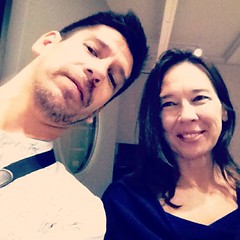


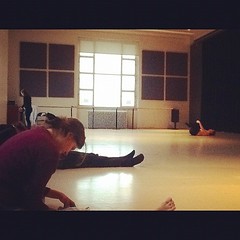
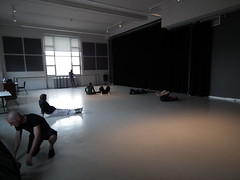
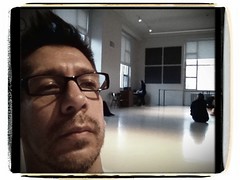
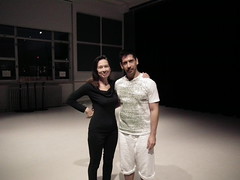

No comments:
Post a Comment